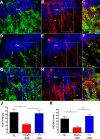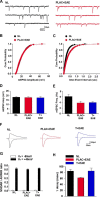Therapeutic testosterone administration preserves excitatory synaptic transmission in the hippocampus during autoimmune demyelinating disease
- PMID: 22956822
- PMCID: PMC3571760
- DOI: 10.1523/JNEUROSCI.2796-12.2012
Therapeutic testosterone administration preserves excitatory synaptic transmission in the hippocampus during autoimmune demyelinating disease
Abstract
Over 50% of multiple sclerosis (MS) patients experience cognitive deficits, and hippocampal-dependent memory impairment has been reported in >30% of these patients. While postmortem pathology studies and in vivo magnetic resonance imaging demonstrate that the hippocampus is targeted in MS, the neuropathology underlying hippocampal dysfunction remains unknown. Furthermore, there are no treatments available to date to effectively prevent neurodegeneration and associated cognitive dysfunction in MS. We have recently demonstrated that the hippocampus is also targeted in experimental autoimmune encephalomyelitis (EAE), the most widely used animal model of MS. The objective of this study was to assess whether a candidate treatment (testosterone) could prevent hippocampal synaptic dysfunction and underlying pathology when administered in either a preventative or a therapeutic (postdisease induction) manner. Electrophysiological studies revealed impairments in basal excitatory synaptic transmission that involved both AMPA receptor-mediated changes in synaptic currents, and faster decay rates of NMDA receptor-mediated currents in mice with EAE. Neuropathology revealed atrophy of the pyramidal and dendritic layers of hippocampal CA1, decreased presynaptic (Synapsin-1) and postsynaptic (postsynaptic density 95; PSD-95) staining, diffuse demyelination, and microglial activation. Testosterone treatment administered either before or after disease induction restores excitatory synaptic transmission as well as presynaptic and postsynaptic protein levels within the hippocampus. Furthermore, cross-modality correlations demonstrate that fluctuations in EPSPs are significantly correlated to changes in postsynaptic protein levels and suggest that PSD-95 is a neuropathological substrate to impaired synaptic transmission in the hippocampus during EAE. This is the first report demonstrating that testosterone is a viable therapeutic treatment option that can restore both hippocampal function and disease-associated pathology that occur during autoimmune disease.
Figures










Similar articles
-
Estriol preserves synaptic transmission in the hippocampus during autoimmune demyelinating disease.Lab Invest. 2012 Aug;92(8):1234-45. doi: 10.1038/labinvest.2012.76. Epub 2012 Apr 23. Lab Invest. 2012. PMID: 22525427 Free PMC article.
-
Platelet-Activating Factor Receptors Mediate Excitatory Postsynaptic Hippocampal Injury in Experimental Autoimmune Encephalomyelitis.J Neurosci. 2016 Jan 27;36(4):1336-46. doi: 10.1523/JNEUROSCI.1171-15.2016. J Neurosci. 2016. PMID: 26818520 Free PMC article.
-
Impaired synaptic clustering of postsynaptic density proteins and altered signal transmission in hippocampal neurons, and disrupted learning behavior in PDZ1 and PDZ2 ligand binding-deficient PSD-95 knockin mice.Mol Brain. 2012 Dec 26;5:43. doi: 10.1186/1756-6606-5-43. Mol Brain. 2012. PMID: 23268962 Free PMC article.
-
Hippocampal CA1 atrophy and synaptic loss during experimental autoimmune encephalomyelitis, EAE.Lab Invest. 2010 May;90(5):774-86. doi: 10.1038/labinvest.2010.6. Epub 2010 Feb 15. Lab Invest. 2010. PMID: 20157291 Free PMC article.
-
Synaptic plasticity in multiple sclerosis and in experimental autoimmune encephalomyelitis.Philos Trans R Soc Lond B Biol Sci. 2013 Dec 2;369(1633):20130162. doi: 10.1098/rstb.2013.0162. Print 2014 Jan 5. Philos Trans R Soc Lond B Biol Sci. 2013. PMID: 24298163 Free PMC article. Review.
Cited by
-
Synaptopathy connects inflammation and neurodegeneration in multiple sclerosis.Nat Rev Neurol. 2015 Dec;11(12):711-24. doi: 10.1038/nrneurol.2015.222. Epub 2015 Nov 20. Nat Rev Neurol. 2015. PMID: 26585978 Review.
-
Sex differences in the neuronal transcriptome and synaptic mitochondrial function in the cerebral cortex of a multiple sclerosis model.Front Neurol. 2023 Nov 2;14:1268411. doi: 10.3389/fneur.2023.1268411. eCollection 2023. Front Neurol. 2023. PMID: 38020654 Free PMC article.
-
Sex, aging and immunity in multiple sclerosis and experimental autoimmune encephalomyelitis: An intriguing interaction.Front Neurol. 2023 Jan 9;13:1104552. doi: 10.3389/fneur.2022.1104552. eCollection 2022. Front Neurol. 2023. PMID: 36698908 Free PMC article. Review.
-
Androgen-Induced Immunosuppression.Front Immunol. 2018 Apr 17;9:794. doi: 10.3389/fimmu.2018.00794. eCollection 2018. Front Immunol. 2018. PMID: 29755457 Free PMC article. Review.
-
The X factor in neurodegeneration.J Exp Med. 2022 Dec 5;219(12):e20211488. doi: 10.1084/jem.20211488. Epub 2022 Nov 4. J Exp Med. 2022. PMID: 36331399 Free PMC article.
References
-
- Amato MP, Portaccio E, Goretti B, Zipoli V, Hakiki B, Giannini M, Pastò Cognitive impairment in early stages of multiple sclerosis. Neurol Sci. 2010;31(Suppl 2):S211–S14. - PubMed
-
- Anderson VM, Fisniku LK, Khaleeli Z, Summers MM, Penny SA, Altmann DR, Thompson AJ, Ron MA, Miller DH. Hippocampal atrophy in relapsing-remitting and primary progressive MS: a comparative study. Mult Scler. 2010;16:1083–1090. - PubMed
-
- Arezzo JC, Litwak MS, Zotova EG. Correlation and dissociation of electrophysiology and histopathology in the assessment of toxic neuropathy. Toxicol Pathol. 2011;39:46–51. - PubMed
-
- Aubert S, Wendling F, Regis J, McGonigal A, Figarella-Branger D, Peragut JC, Girard N, Chauvel P, Bartolomei F. Local and remote epileptogenicity in focal cortical dysplasias and neurodevelopmental tumours. Brain. 2009;132:3072–3086. - PubMed
-
- Barreto G, Veiga S, Azcoitia I, Garcia-Segura LM, Garcia-Ovejero D. Testosterone decreases reactive astroglia and reactive microglia after brain injury in male rates: role of its metabolites, oestrodial and dihydrotestosterone. Eur J Neurosci. 2007;25:3039–3046. - PubMed
Publication types
MeSH terms
Substances
Grants and funding
LinkOut - more resources
Full Text Sources
Medical
Miscellaneous
